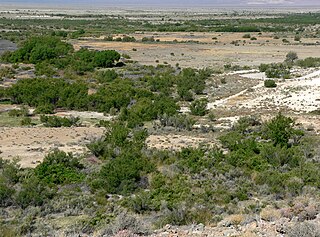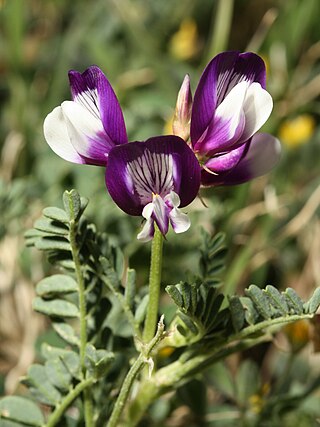
Astragalus is a large genus of over 3,000 species of herbs and small shrubs, belonging to the legume family Fabaceae and the subfamily Faboideae. It is the largest genus of plants in terms of described species. The genus is native to temperate regions of the Northern Hemisphere. Common names include milkvetch, locoweed and goat's-thorn. Some pale-flowered vetches are similar in appearance, but they are more vine-like than Astragalus.

The Ash Meadows National Wildlife Refuge is a protected wildlife refuge located in the Amargosa Valley of southern Nye County, in southwestern Nevada. It is directly east of Death Valley National Park, and is 90 mi (140 km) west-northwest of Las Vegas.

Astragalus alpinus is a species of flowering plant in the legume family known by the common name alpine milkvetch. It has a circumpolar distribution, occurring throughout the upper latitudes of the Northern Hemisphere.

Astragalus canadensis is a common and widespread member of the milkvetch genus in the legume family, known commonly as Canadian milkvetch. The plant is found throughout Canada and the United States in many habitats including wetlands, woodlands, and prairies.

Astragalus lentiginosus Astragalus lentiginosus is a species of legume native to western North America where it grows in a range of habitats. Common names include spotted locoweed and freckled milkvetch. There are a great number of wild varieties. The flower and the fruit of an individual plant are generally needed to identify the specific variety.
Astragalus anxius is a rare species of milkvetch known by the common names troubled milkvetch and Ash Valley milkvetch. It is endemic to northern Lassen County, California, where it is critically imperiled. It was formally described in 1992.

Astragalus didymocarpus is a species of milkvetch known by the common names Dwarf white milkvetch and Two-seeded milkvetch. It is native to the southwestern United States and northern Mexico, where it can be found in many types of habitat.

Astragalus kentrophyta is a species of milkvetch known by the common name spiny milkvetch. It is native to western North America from central to west Canada, to California, to New Mexico. It grows in rocky mountainous areas, such as the Sierra Nevada, and on plateaus.
Astragalus mohavensis is a species of milkvetch known by the common name Mojave milkvetch. It is native to the Mojave Desert of California and Nevada.

Astragalus nuttallianus is a species of milkvetch known by the common names smallflower milkvetch and turkeypeas. It is native to the southwestern and south central United States and northern Mexico, where it can be found in many types of habitat, often in dry areas.

Astragalus oophorus is a species of milkvetch known by the common name egg milkvetch. It is native to the western United States, mainly California and Nevada, though one variety can be found as far east as Colorado. It is a plant of sagebrush and other dry habitat.
Astragalus lentiginosus var. pseudiodanthus, synonym Astragalus pseudiodanthus, is a variety of the species Astragalus lentiginosus, a milkvetch. It is known by the common name Tonopah milkvetch. It is native to the Great Basin deserts of Nevada and eastern California, such as the Tonopah area, where it grows in sandy habitat.

Astragalus purshii is a species of milkvetch known by the common names woollypod milkvetch and Pursh's milkvetch.

Astragalus pycnostachyus is a species of milkvetch known by the common name marsh milkvetch. It is endemic to the coastline of California, where it grows in wet saline habitat such as marshes.

Astragalus ampullarioides is a rare species of milkvetch known by the common name Shivwits milkvetch. It was previously classified as a variety of Astragalus eremiticus. It is endemic to Washington County, Utah, where it is known from only seven populations. Estimates of the total number of individuals range from 1000 to 4200. The species occurs in desert scrub and woodlands on the Chinle Formation. It is a federally listed endangered species.

Astragalus cremnophylax is a rare species of milkvetch known by the common names sentry milkvetch and cliff milkvetch. It is endemic to Arizona, where the three varieties grow in three separate locations. The rarest variety, var. cremnophylax, is a federally listed endangered species which grows only on the rim of the Grand Canyon. The two other varieties are known from the Buckskin Mountains and Marble Canyon.

Astragalus phoenix is a rare species of milkvetch known by the common name Ash Meadows milkvetch. It is endemic to Nye County, in southwestern Nevada.

Mentzelia leucophylla, known by the common name Ash Meadows blazingstar, is a rare species of flowering plant in the Loasaceae. It is endemic to southwestern Nevada, in the Western United States.

Astragalus limnocharis var. montii, synonym Astragalus montii, is a rare variety of flowering plant in the legume family. It is known by the common name Monti's milkvetch. It is endemic to Utah in the United States, where there are only three known populations. Under the synonym A. montii, it is a federally listed threatened species of the United States.

Astragalus australis is a species of flowering plant in the legume family known by the common name Indian milkvetch. It is native to much of the Northern Hemisphere, including northern North America, Europe, and temperate Asia.


















